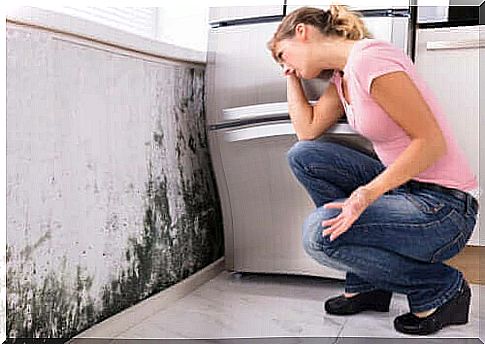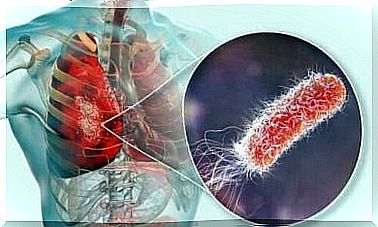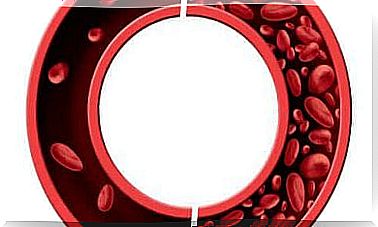Can Mold In The House Lead To Health Problems?

The presence of mold in the house causes problems that can go beyond structural damage. Its odors and stains on walls and ceilings are particularly noticeable. In fact, this type of fungus can be the cause of health problems in the long run.
According to information published by the Centers for Disease Control and Prevention, exposure to humid and moldy environments leads to allergies and respiratory problems in some people. It can also trigger a crisis in people with asthma.
What exactly is mold?
As we said above, this is a type of fungus that grows both indoors and outdoors. It usually occurs in areas with high humidity, such as ceilings or walls where water leaks, in windows, pipes or anywhere there is frequent contact with liquids.
In the same way, it grows on cardboard elements, wood products, plaster, carpets and paint. The spores flow and spread easily through the air. Then the form thrives and grows if the environment is hot and humid.
According to an article in the journal Environmental Health Perspectives , there are around 500 fungal species that are harmful to human health. However, the most common indoor types of mold are cladosporium, penicillium and aspergillus.

Types of mold
We do not know exactly how many types of mold there are in the world. Some suggest that it may be 100,000, while others state that it is 300,000 or more. In any case, around 500 have been identified as potentially harmful to humans. Of these, these are the most famous:
- Alternaria belongs to sack spore fungi and tends to develop in damp places around the house such as the shower or during leaking sinks.
- Aspergillus is a form that can grow indoors, on dust, on food or in building materials. It often leads to allergies and can even be toxic and lead to swelling and breathing problems.
- Cladosporium is a fungus that grows in both cold and hot areas. It usually grows on textiles and wood surfaces and also causes allergies.
- Penicillium has a blue or green surface and a velvety texture. It usually grows in buildings or houses that are damaged by water, and also in carpets, wallpaper and mattresses. Its presence in the home increases the risk of respiratory diseases.
- Acremonium is a variety with a characteristic pink, gray, orange or white tone. It usually grows in areas with condensation, such as humidifiers, drainage boards and window seals. It is one of the most dangerous species, associated with bone marrow and immune system diseases.
How does mold get into the house?
Mold spores are present both indoors and outdoors, but are not visible to the naked eye. In both cases , these enter a house through windows, open doors, ventilation ducts or air conditioning and heating systems.
They can also attach themselves to objects, such as clothes and shoes, and then sneak indoors with the person using them. They often take a walk in the pet’s fur. The mold will grow if the right humidity conditions exist in a home, otherwise it will not cause problems.
Mold and health problems
The presence of mold in the house is usually not a problem unless the spores come in contact with damp rooms and begin to grow. There is a real health risk when this happens, especially if the occupants of a house have existing respiratory problems or the immune system.
Possible allergies
Mold growth in the home can aggravate the symptoms of anyone with allergies. In particular, it triggers symptoms such as stuffy nose, itchy nose and throat, sneezing, watery eyes and excess mucus.
Early exposure to mold or moisture also appears to increase the risk of asthma and rhinitis. At least according to a study published in the Allergy journal.
Mold in the house increases the risk of respiratory disease
Mold is also associated with other respiratory diseases in addition to allergies. The research reported in Environmental Health magazine determined that moisture and mold in homes significantly increased the risk of respiratory infections, such as bronchitis and also these:
- Hypersensitivity pneumonitis
- Allergic alveolitis
- Chronic rhinosinusitis
- Sinusitis
- Lower respiratory problems in previously healthy children
Aspergillosis
Contact with Aspergillus mold can lead to a serious disease known as aspergillosis. This can cause a serious infection that can even spread to other parts of the body. Its symptoms range from chronic cough to coughing and bleeding, fever, wheezing and weight loss. It can also manifest itself as:
- Leg pain
- Chest pain
- Freezing
- A reduction in urine volume
- Headache
- Respiratory failure
- Visual impairment
- Skin lesions

This is how you can prevent health problems caused by mold in the house
Of course, there are several measures to prevent mold as well as prevent it from endangering your health. One of the most important is to ensure clean, ventilated and moisture-free rooms. In this regard, the Environmental Protection Agency (EPA) proposes to keep the humidity level below 60%.
Other recommendations are:
- Resolve any leaks and wipe off water spills immediately.
- Install a dehumidifier to reduce indoor humidity.
- Open windows to allow air to circulate.
- Install an extractor fan to absorb moisture during cooking.
- Avoid drying clothes indoors.
- Empty and ventilate cabinets, especially if you do not use them often.
- Clean all moldy surfaces regularly, such as walls, ceilings, furniture, etc.
- Use fungicides to disinfect the bathroom and other rooms that are exposed to moisture.
- Call a professional to resolve any structural issues that facilitate the presence of mold.
It is important to consult a doctor when there is mold in the house
Mold exposure does not always cause health problems. Nevertheless, the best preventive measure is to prevent it completely. Talk to your doctor if you have symptoms of allergies or respiratory deficiencies. Do not ignore them as they can lead to serious complications.
Remember that mold is not always the cause of disease, but can aggravate other pre-existing conditions. Thus, you need to follow the recommendations of a professional to solve any moisture problems as soon as possible.









